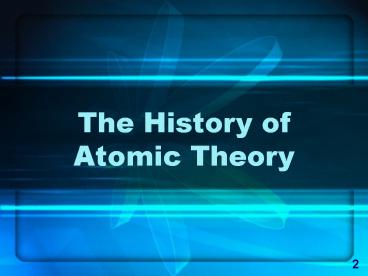The History of Atomic Theory - PowerPoint PPT Presentation
1 / 24
Title:
The History of Atomic Theory
Description:
2 Cartoon of the day Today s Warm-up Warm-up: Black-box With your lab group of 4, investigate and predict (w/out opening) what is in your black box How did ... – PowerPoint PPT presentation
Number of Views:470
Avg rating:3.0/5.0
Title: The History of Atomic Theory
1
The History of Atomic Theory
2
2
Cartoon of the day
3
Todays Warm-up
- Warm-up Black-box
- With your lab group of 4, investigate and predict
(w/out opening) what is in your black box - How did you come to that conclusion?
- What senses did you use?
- Did you use any tools?
- Can you think of any tools that would make your
prediction more likely or accurate?
4
Atomic Theory History Models
Notes
Questions Vocabulary words Formulas Main
Ideas Possible Test Questions Key Concepts
Notes
Notes
Notes
Notes
Notes
Notes
Notes
Notes
Notes
Summary of the notes and information learned
5
Todays Research
- Famous scientists who contributed to the atomic
theory/atomic model (not in any order) - John Dalton
- Aristotle and Democritus
- alchemists
- J.J. Thompson
- electron cloud model
- Niels Bohr
- Earnest Rutherford
6
Atomic Structure Timeline
- Requirements (work in lab groups of 4)
- Must include a title.
- Must include a spot for each of the 7 items.
- Must include at least the Who, When, and What.
- Must have a picture/drawing (color is preferred)
for each item. - Options
- Comic book format
- Standard timeline
- PowerPoint slideshow
- Other???
History of Atomic Structure History of the
Atomic Model
7
Ancient Philosophy
- Who Aristotle, Democritus
- When More than 2000 years ago
- Where Greece
- What Aristotle believed in 4 elements Earth,
Air, Fire, and Water. Democritus believed that
matter was made of small particles he named
atoms. - Why Aristotle and Democritus used observation
and inference to explain the existence of
everything.
8
Democritus
Aristotle
9
Alchemists
- Who European Scientists
- When 800 900 years ago
- Where Europe
- What Their work developed into what is now
modern chemistry. - Why Trying to change ordinary materials into
gold.
10
Alchemic Symbols
11
Atomic Particle Theory
- Who John Dalton
- When 1808
- Where England
- What Described atoms as tiny particles that
could not be divided. Thought each element was
made of its own kind of atom. Developed the
Atomic Theory - Why Building on the ideas of Democritus in
ancient Greece.
12
Daltons Atomic Theory
- 1 Elements are composed of small indivisible
particles (atoms) - 2 Atoms of the same element are identical. Atoms
of different elements are different. - 3 Atoms of different elements combine together
in simple proportions to create compounds. - 4 In a chemical reaction, atoms are rearranged,
but not changed.
13
John Dalton
14
Discovery of Electrons
- Who J. J. Thompson
- When 1897
- Where England
- What Thompson discovered that electrons were
smaller particles of an atom and were negatively
charged. - Why Thompson knew atoms were neutrally charged,
but couldnt find the positive particle.
15
J. J. Thompson
16
Atomic Structure I
- Who Ernest Rutherford
- When 1911
- Where England
- What Conducted an experiment to isolate the
positive particles in an atom. Decided that the
atoms were mostly empty space, but had a dense
central core. (gold foil exp.) - Why He knew that atoms had positive and negative
particles, but could not decide how they were
arranged.
17
Ernest Rutherford
18
Atomic Structure II
- Who Niels Bohr
- When 1913
- Where England
- What Proposed that electrons traveled in fixed
paths around the nucleus. Scientists still use
the Bohr model to show the number of electrons in
each orbit around the nucleus. - Why Bohr was trying to show why the negative
electrons were not sucked into the nucleus of the
atom.
19
Niels Bohr
20
Electron Cloud Model
- Electrons travel around the nucleus in random
orbits. - Scientists cannot predict where they will be at
any given moment. - Electrons travel so fast, they appear to form a
cloud around the nucleus.
21
Electron Cloud Model
22
Atomic Structure Timeline
- Requirements
- Must include a title.
- Must include a spot for each of the 7 items.
- Must include at least the Who, When, and What.
- Must have a picture (color is preferred) for each
item. - Options
- Comic book format
- Standard timeline
- PowerPoint slideshow
- Other???
23
Atomic Theory History Models
Notes
Questions Vocabulary words Formulas Main
Ideas Possible Test Questions
Notes
Notes
Notes
Notes
Notes
Notes
Notes
Notes
Notes
Summary of the notes and information learned
24
Make it a great day Mustangs!































